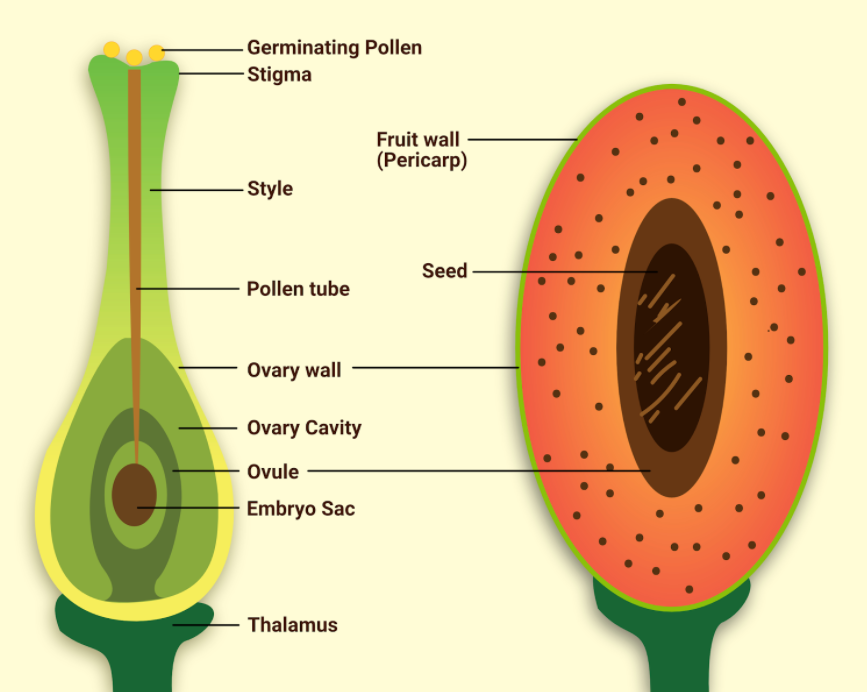
The ovary ripens to form fruit.
(a) True
(b) False
Answer
492k+ views
Hint: In angiosperm, the ovary matures to form a seed-bearing structure in flowering plants. Most of it is edible and they help in the dispersal of seeds. They are a rich source of providing nutrition.
Complete step by step answer:
The ovary is the Basal, swollen part of the carpel. It is the lower part of the carpel which bears one or more ovules. These ovules after fertilization mature into seeds.

The ovules are attached to a flattened cushion- like structure called the placenta. The ovary matures and develops into a fruit. The wall of the ovary after fertilization forms the pericarp (fruit wall).
Additional information: - The flowering plant or the angiosperms are characterized by the presence of fruit.
- After fertilization, the ripened ovary is called fruit. Parts of fruits are namely fruit wall and seed. - The fruit wall also known as pericarp develops from the wall of the ovary, it can be dry or fleshy.
- If the pericarp is thick and fleshy, then it differentiates into three layers namely: - Epicarp (outer covering) - Mesocarp (middle layer) - Endocarp (inner- most layer) The seed develops from ovules. This later grows into a plant.
The fruit which develops from the ovary is called true fruit. If any other floral part takes part in fruit formation, it is called false fruit or pseudocarp. Example: apple and pear.
So, the answer is, ‘True.’
Note: - Some fruits are formed without fertilization and are seedless, these are known as parthenocarpic fruits. For example, Bananas and grapes. - Simple fruits develop from the syncarpous ovary of a single flower with or without accessory parts. - Aggregate fruits are formed from the polycarpellary, apocarpous ovary. Each carpel develops into a fruitlet and all the fruitlets together form an aggregate fruit. The multiple fruits develop from the entire inflorescence. For example, Raspberry and Strawberry.
Complete step by step answer:
The ovary is the Basal, swollen part of the carpel. It is the lower part of the carpel which bears one or more ovules. These ovules after fertilization mature into seeds.

The ovules are attached to a flattened cushion- like structure called the placenta. The ovary matures and develops into a fruit. The wall of the ovary after fertilization forms the pericarp (fruit wall).
Additional information: - The flowering plant or the angiosperms are characterized by the presence of fruit.
- After fertilization, the ripened ovary is called fruit. Parts of fruits are namely fruit wall and seed. - The fruit wall also known as pericarp develops from the wall of the ovary, it can be dry or fleshy.
- If the pericarp is thick and fleshy, then it differentiates into three layers namely: - Epicarp (outer covering) - Mesocarp (middle layer) - Endocarp (inner- most layer) The seed develops from ovules. This later grows into a plant.
The fruit which develops from the ovary is called true fruit. If any other floral part takes part in fruit formation, it is called false fruit or pseudocarp. Example: apple and pear.
So, the answer is, ‘True.’
Note: - Some fruits are formed without fertilization and are seedless, these are known as parthenocarpic fruits. For example, Bananas and grapes. - Simple fruits develop from the syncarpous ovary of a single flower with or without accessory parts. - Aggregate fruits are formed from the polycarpellary, apocarpous ovary. Each carpel develops into a fruitlet and all the fruitlets together form an aggregate fruit. The multiple fruits develop from the entire inflorescence. For example, Raspberry and Strawberry.
Recently Updated Pages
Master Class 11 Economics: Engaging Questions & Answers for Success

Master Class 11 Business Studies: Engaging Questions & Answers for Success

Master Class 11 Accountancy: Engaging Questions & Answers for Success

Master Class 11 English: Engaging Questions & Answers for Success

Master Class 11 Computer Science: Engaging Questions & Answers for Success

Master Class 11 Maths: Engaging Questions & Answers for Success

Trending doubts
Which one is a true fish A Jellyfish B Starfish C Dogfish class 11 biology CBSE

State and prove Bernoullis theorem class 11 physics CBSE

1 ton equals to A 100 kg B 1000 kg C 10 kg D 10000 class 11 physics CBSE

In which part of the body the blood is purified oxygenation class 11 biology CBSE

One Metric ton is equal to kg A 10000 B 1000 C 100 class 11 physics CBSE

Difference Between Prokaryotic Cells and Eukaryotic Cells




